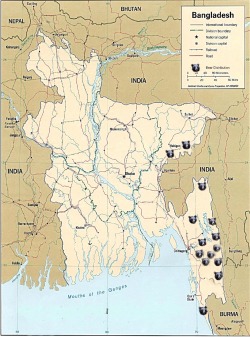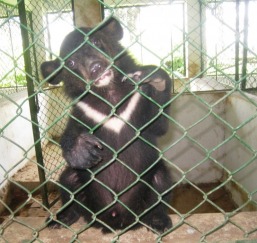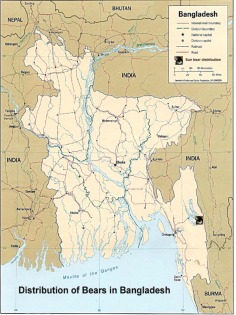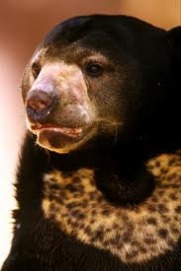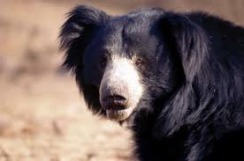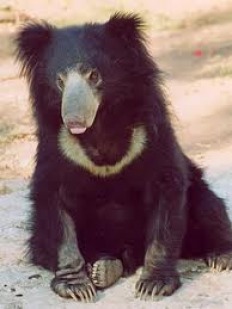PROFILES OF BEARS OF BANGLADESH
In Bangladesh three species of bears have been reported (IUCN 2000). These are described below
|
Asiatic Black Bear
Ursus thibetanus G. Cuvier, 1823 [Previously Selenarctos thibetanus (G. Cuvier, 1823)] Class Mammalia Order Carnivora Family Ursidae Local names Kalo Bhalluk Other English names Himalayan Black Bear, Moon Bear Status Endangered Description: Body glossy black, lower lip white and a narrow distinctive crescent or horse-shoe mark on the chest. Fur smooth, hairs of moderate length. Snout pointed; ears large, Head-body length 120-220 cm; shoulder height 75 cm. Weight 90-180 kg. Habits: Both diurnal and nocturnal, can climb and swim well. Generally solitary except for young who remain together with mother for the first year. Diet consist of plant matter, insects (especially termites), and honey comb. Usually 2 or 3 cubs are produced in winter after a gestation period of 7 months. Habitats: Steep forested hills. Distribution: Mixed evergreen and semi-evergreen forest of SE. Threats: Habitat loss. Conservation status: Included in CITES Appendix I; 3rd Schedule BW (P)(A)A 1974. Conservation needs: Habitat protection and restoration. Extra-territorial distribution: Iran, Afghanistan, Pakistan, India, Nepal, Bhutan, Myanmar, Thailand, Vietnam, Laos, Cambodia, China, Japan and Russia. (Khan 1985, Menon 2003, Prater 1993, Sarker 2006, Sanderson 1972). Remarks: Scientific name, Ursus thibetanus, literally means, moon bear of Tibet, and it is easily distinguishable by the crescent shaped area of white fur on its chest. The Asiatic Black Bear are much closer to American Black Bears but have a heavy, stocky body than the later. Their ears are also large and set far apart on their large, round head (Chakma 2009). |
|
Sun Bear
Ursus malayanus Raffles, 1821 [Previously Helarctos malayanus (Raffles 1821)] Class Mammalia Order Carnivora Family Ursidae Local names Bhalluk Other English names Malayan Sun Bear, Honey Bear Status Critically Endangered "Probably Extirpated from Bangladesh" Description: Smallest of all the ursids. Body jet black, face dirty-whitish. The muzzle eyes and chin pale, often whitish. There is a horseshoe or U-shaped incomplete ring on the chest. Tongue quite long; ears rounded; hairs short and fine. Feet relatively large to body size, with bowed front legs and in turned paws. Head-body length 110-140 cm; tail 5 cm; shoulder height 70 cm. Weight 27-65 kg. Habits: An agile climber; solitary and active at night. Feeds on fruits and leaves, and also on termites, bees, earthworms and other insects, occasionally other animals like birds. Habitats: Hill forests of tropical and sub-tropical regions. Distribution: Mixed evergreen of NE and SE. Threats: Habitat loss. Conservation status: Included in CITES Appendix I; 3rd Schedule BW (P)(A)A 1974. Conservation needs:Habitat protection and restoration. Extra-territorial distribution:India, Myanmar, Thailand, Vietnam, Laos, Cambodia, China, Indonesia and Malaysia (Khan 1985, Menon 2003, Prater 1993, Sarker 2006, Sanderson 1972). Remarks:The generic name Helarctos is derived from two words (Greek: hela = sun; arcto = bear), therefore it refers to Sun Bear. It is said that the origin of the name Sun Bear because of its yellow crescent mark represents to the rising sun. The generic name Ursus is more appropriate than Helarctos for this species (Malayan Sun Bear). In a few countries like Thailand the species is known as dog bear probably for their small size, short hair; smaller head (Chakma 2009). |
|
Sloth Bear
Melursus ursinus (Shaw and Nodder 1791) Class Mammalia Order Carnivora Family Ursidae Local names Bhalluk Other English name Indian Bear, Status Critically Endangered Description: A black, bulky creature with an off-white and elongated muzzle, and a very short tail; white claws. Body covered with shaggy fur, longest between the shoulders. There is a prominent white V-shaped marking on the chest; ears hairy. Head-body length 130-180 cm; tail 10-13 cm; shoulder height 65-100 cm. Weight 55-145 kg. Habits: Lives in shallow caves, alone or in small family groups; can climb trees. Feeds mainly on termites, insect larvae, fruits, honey and bird eggs. Breeds in summer after a gestation period of 7 months; 1 or 2 (occasionally 3) cubs are born, which may remain with the mother for 2-3 years. Habitats: Forested area, outcroppings in rocks and tumbled boulders. Distribution: Mixed evergreen of NE and SE. Threats: Habitat loss. Conservation status: Included in CITES Appendix II; 3rd Schedule BW (P)(A)A 1974. Conservation needs: Habitat protection and restoration. Extra-territorial distribution: India, Sri Lanka. (Khan 1985, Menon 2003, Prater 1993, Sarker 2006, Sanderson 1972). Remarks: In some classification this genus is not a separate genus from Ursus. Their natural lifespan is unknown; however, a captive specimen was recorded to have lived 40 years (Chakma 2009). |
Copyright © Wildlife Trust of Bangladesh, 69/1 New Circular Road, Malibagh, Dhaka 1217,Phone: +88-02-9355576

